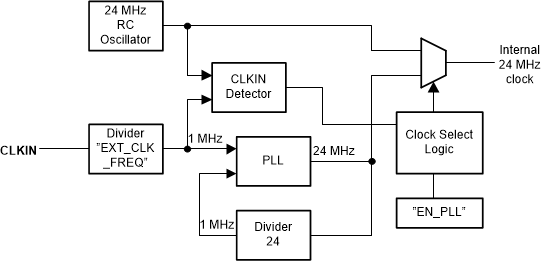JAJSLM6 March 2021 LP87702
PRODUCTION DATA
- 1 特長
- 2 アプリケーション
- 3 概要
- 4 Revision History
- 5 Pin Configuration and Functions
- 6 Specifications
-
7 Detailed Description
- 7.1 Overview
- 7.2 Functional Block Diagram
- 7.3
Feature Descriptions
- 7.3.1 Step-Down DC/DC Converters
- 7.3.2 Boost Converter
- 7.3.3 Spread-Spectrum Mode
- 7.3.4 Sync Clock Functionality
- 7.3.5 Power-Up
- 7.3.6 Buck and Boost Control
- 7.3.7 Enable and Disable Sequences
- 7.3.8 Window Watchdog
- 7.3.9 Device Reset Scenarios
- 7.3.10 Diagnostics and Protection Features
- 7.3.11 OTP Error Correction
- 7.3.12 Operation of GPO Signals
- 7.3.13 Digital Signal Filtering
- 7.4 Device Functional Modes
- 7.5 Programming
- 7.6 Register Maps
- 8 Application and Implementation
- 9 Power Supply Recommendations
- 10Layout
- 11Device and Documentation Support
- 12Mechanical, Packaging, and Orderable Information
パッケージ・オプション
メカニカル・データ(パッケージ|ピン)
- RHB|32
サーマルパッド・メカニカル・データ
- RHB|32
発注情報
7.3.4 Sync Clock Functionality
The LP87702 device contains a CLKIN input to synchronize buck and boost converters' switching clock with the external clock. Figure 7-3 shows the block diagram of the clocking and PLL module. Table 7-2 shows how the external clock is selected and interrupt is generated depending on the EN_PLL bit in PLL_CTRL register and the external clock availability. The interrupt can be masked with SYNC_CLK_MASK bit in TOP_MASK_1 register. The nominal frequency of the external input clock is set by EXT_CLK_FREQ[4:0] bits in PLL_CTRL register and it can be from 1 MHz to 24 MHz with 1-MHz steps. The external clock must be inside accuracy limits (–30%/+10%) for valid clock detection.
The SYNC_CLK_INT interrupt in INT_TOP_1 register is also generated in cases the external clock is expected but it is not available. These cases are Startup (Read OTP-to-standby transition) when EN_PLL = 1 and buck or boost converter is enabled (standby-to-active transition) when EN_PLL = 1.
 Figure 7-3 Clock and PLL Module
Figure 7-3 Clock and PLL Module| DEVICE OPERATION MODE | EN_PLL | PLL AND CLOCK DETECTOR STATE | INTERRUPT FOR EXTERNAL CLOCK | CLOCK |
|---|---|---|---|---|
| STANDBY | 0 | Disabled | No | Internal RC |
| ACTIVE | 0 | Disabled | No | Internal RC |
| STANDBY | 1 | Enabled | When external clock disappears or appears | Automatic change to internal RC oscillator when External clock is not available |
| ACTIVE | 1 | Enabled | When external clock disappears or appears | Automatic change to internal RC oscillator when External clock is not available |